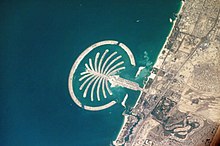Palm Jumeirah - Simple English Wikipedia, the free encyclopedia


Palm Jumeirah is an artificial island on the coast of Dubai, United Arab Emirates. Nakheel is the real estate developer of this artificial island.[1] It is the site of numerous private residences and hotels. From the air, the archipelago resembles a stylized palm tree within a circle. The creation of the island started in 2001 ending around 2006/2007 and was financed mainly from Dubai's income from petroleum. By 2009, 28 hotels were opened on the site. The Atlantis is the largest hotel currently constructed on Palm Jumeirah. There are currently over 18,000 thousand living on the island. [2] It was built entirely from sand and rocks, no concrete or steel was used to build the island. This was done in accordance with the order of the Ruler of Dubai, who came up with the idea and the design.[3]
Purpose
[change | change source]Dubai built the Island to increase the coastline for tourists. Dubai is known for its sunny weather and beaches, but the existing 72 Km coastline was not enough to accommodate the goal of tripling the number of tourists to 15 million annually. The solution was to construct a massive island shaped like a Palm Tree, which upon completion in 2006, would add 56 Km to the coastline. The island was designed to be a city within itself, featuring shopping centers, restaurants, hotels, and residential properties. [4]
References
[change | change source]- ↑ Sayegh, Hadeel Al (8 November 2022). "Dubai Palm Island developer gets $4.6 bln funding for new waterfront projects". Reuters. Retrieved 2 January 2023.
- ↑ "Palm Jumeirah, Dubai, United Arab Emirates - City Facts".
- ↑ "Dubai Palm Island | HQ Travel Guide". hqtravel.net. Retrieved 2014-01-25.
- ↑ "The Palm Island, Dubai UAE - Megastructure Development". www.wermac.org. Retrieved 2023-01-24.


 French
French Deutsch
Deutsch